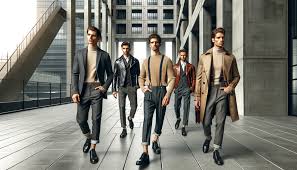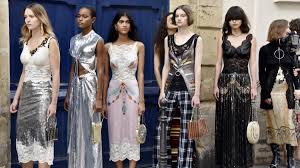In recent years, the fashion industry has witnessed a profound shift towards sustainability, with vintage styles emerging as a prominent trend. This movement reflects a growing awareness of the environmental impact of fast fashion and a desire to embrace more eco-friendly practices. As consumers become increasingly conscious of their choices, vintage fashion offers a unique blend of style and sustainability. This article explores how vintage styles are reshaping the fashion landscape, the benefits of sustainable fashion, and practical tips for incorporating vintage pieces into your wardrobe.
1. The Appeal of Vintage Fashion

1.1 A Nod to Nostalgia
Vintage fashion is more than just a trend; it’s a celebration of nostalgia. Each piece carries a story and represents a particular era’s unique aesthetic. Whether it’s the elegance of the 1950s or the eclectic patterns of the 1970s, vintage clothing evokes a sense of history and timelessness. This nostalgia appeals to consumers who seek to connect with the past while expressing their individuality in the present.
1.2 Unique and Timeless Style
One of the major appeals of vintage fashion is its uniqueness. Unlike contemporary clothing, which can often feel homogeneous due to mass production, vintage pieces are distinctive and rare. This rarity allows fashion enthusiasts to stand out and create a personal style that’s truly their own. Additionally, many vintage garments are designed with a level of craftsmanship and attention to detail that is not always present in modern clothing.
1.3 Quality and Durability
Vintage clothing often boasts superior quality and durability. Before the rise of fast fashion, clothing was made to last, using high-quality materials and meticulous construction methods. As a result, many vintage garments have stood the test of time and remain in excellent condition. Investing in vintage pieces not only provides a unique style but also ensures that the items you wear are built to endure.
2. The Rise of Sustainable Fashion
2.1 Environmental Impact of Fast Fashion
Fast fashion has contributed significantly to environmental degradation. The industry’s rapid production cycles, use of synthetic materials, and wasteful practices lead to massive amounts of textile waste and pollution. By contrast, sustainable fashion aims to mitigate these negative impacts by promoting ethical production methods and environmentally friendly materials.
2.2 Vintage Clothing as a Sustainable Choice
Vintage clothing is a key component of sustainable fashion. By reusing and repurposing garments from previous decades, vintage fashion reduces the demand for new clothing production. This practice helps decrease textile waste and lowers the overall carbon footprint associated with the fashion industry. Additionally, vintage shopping supports a circular economy, where products are continuously reused and recycled rather than discarded.
2.3 Supporting Ethical Practices
Vintage shopping also supports ethical practices by promoting fair trade and reducing exploitation. Unlike fast fashion, which often relies on low-wage labor in developing countries, vintage clothing is typically sourced from second-hand shops, thrift stores, and estate sales. This not only helps prevent unethical labor practices but also provides a more transparent supply chain.
3. How to Incorporate Vintage Styles into Your Wardrobe
3.1 Finding the Perfect Vintage Pieces
To start incorporating vintage styles into your wardrobe, begin by exploring various sources. Thrift stores, consignment shops, and online vintage marketplaces are excellent places to find unique and high-quality pieces. Look for items that resonate with your personal style and complement your existing wardrobe. Pay attention to fabric quality, condition, and fit to ensure that the vintage garments you choose are both stylish and wearable.
3.2 Mixing Vintage with Modern Pieces
One of the best ways to incorporate vintage styles into your wardrobe is by blending them with modern clothing. This approach allows you to create a balanced look that combines the best of both worlds. For example, pair a vintage blazer with contemporary jeans or a retro dress with modern accessories. Mixing and matching helps to update classic pieces and make them more relevant to today’s fashion trends.
3.3 Upcycling and DIY Projects
Upcycling is another way to embrace vintage fashion sustainably. This involves taking old or outdated clothing and transforming it into something new and fashionable. DIY projects can include altering vintage garments to fit your style, adding embellishments, or repurposing materials to create unique accessories. Upcycling not only extends the life of vintage clothing but also allows for creative expression.
3.4 Building a Timeless Wardrobe
Investing in vintage pieces can help you build a timeless wardrobe. Focus on classic items that never go out of style, such as tailored blazers, well-fitted trousers, and elegant dresses. By curating a collection of versatile vintage garments, you can create a wardrobe that remains stylish and relevant for years to come. This approach minimizes the need for frequent shopping and reduces overall consumption.
4. The Future of Vintage Fashion

4.1 Growing Popularity and Market Expansion
The popularity of vintage fashion is on the rise, with more consumers and designers embracing its sustainable benefits. As awareness of environmental issues continues to grow, vintage clothing is becoming a mainstream choice for fashion enthusiasts. This trend is reflected in the expansion of vintage markets, both physical and online, making it easier for consumers to access and appreciate vintage styles.
4.2 Innovations in Vintage Retail
Vintage retail is also evolving to meet modern demands. Innovative approaches, such as curated vintage collections, personalized shopping experiences, and online platforms with advanced search features, are enhancing the vintage shopping experience. These innovations make it easier for consumers to find high-quality vintage pieces that suit their tastes and preferences.
4.3 Collaboration with Contemporary Designers
Many contemporary designers are incorporating vintage elements into their collections, creating a fusion of old and new styles. These collaborations highlight the timeless appeal of vintage fashion and bring fresh perspectives to classic designs. By blending vintage aesthetics with modern creativity, designers are further promoting the sustainability and relevance of vintage clothing.
Conclusion
The rise of vintage styles in sustainable fashion represents a positive shift towards more eco-friendly and ethical practices in the industry. Vintage clothing offers a unique blend of nostalgia, quality, and individuality, making it an appealing choice for those seeking to reduce their environmental impact. By incorporating vintage pieces into your wardrobe, you not only contribute to a more sustainable fashion industry but also embrace a timeless style that transcends trends. As the fashion landscape continues to evolve, the enduring appeal of vintage fashion serves as a reminder of the value of craftsmanship, history, and conscious consumption.


